论文标题:Research Progress and Future Trends in Biomass Energy Spatial Planning
期刊:Landscape Architecture Frontiers
作者:Yifei ZHANG, Keqing QU, Chenshuo MA, Chanyun LI
发表时间:15 Jun 2025
DOI:10.15302/J-LAF-1-020108
微信链接:点击此处阅读微信文章


注:本文为删减版,不可直接引用。原中英文全文刊发于《景观设计学(中英文)》(Landscape Architecture Frontiers)2024年第13卷第3期。
导 读
生物质能作为储量丰富且可再生的清洁能源,可为缓解化石能源使用所引发的环境危机和全球碳中和目标的实现提供有力支持。生物质能空间规划研究具有高度复杂性和学科交叉特征,现有文献在研究尺度和内容方面呈现出多样化态势,但欠缺从全局角度形成研究内容框架的综述类研究。因此,本研究首先借助CiteSpace可视化图谱呈现该领域的研究动态。进而,以“能源景观”理论为基础,构建“资源–供应链–需求–优化”的空间运营逻辑及相应的生物质能空间规划研究框架。通过从潜力评估、供应链、能源需求、供需空间匹配优化四方面梳理现有研究,建立研究内容、方法和各研究方向之间的联系,增强生物质能相关评估和空间规划方案的实操性,提升生物质能空间优化方案的科学性和适用性。最后,研究展望了未来研究方向,强调后续研究应进一步加强能源规划与空间规划的融合,通过科学规划与合理布局充分发挥可再生能源的空间附加价值,实现可持续发展。
关键词
可再生能源;能源景观;潜力估算;供应链;供需匹配;生物质热电厂
生物质能空间规划研究进展
与趋势展望
Research Progress and Future Trends
in Biomass Energy Spatial Planning

1 哈尔滨工业大学建筑与设计学院
2 寒地城乡人居环境科学与技术工业
和信息化部重点实验室
本文引用格式 / PLEASE CITE THIS ARTICLE AS
Zhang, Y., Qu, K., Ma, C., & Li, C. (2025). Research Progress and Future Trends in Biomass Energy Spatial Planning. Landscape Architecture Frontiers, 13(3), 20–41. https://doi.org/10.15302/J-LAF-1-020108
01.引言
全球经济快速发展长期依赖化石能源,由此引发了多种环境危机。生物质能作为一种清洁能源,具备零/负碳排放的优势,可为能源结构转型和全球碳中和目标的实现提供有力支持。随着城市规划空间布局的引导,可再生能源中远期目标逐渐从集中式发电转型到分布式发电,使得新建基础设施与人口聚集区的空间结合将更加紧密,进而改变城市景观。
生物质能空间规划是基于能源建模与空间分析方法,通过分析生物质能现状、空间分异特征与其随时间变化规律,统筹资源分布、交通条件和需求端布局,进而实现生物质能转换设施的空间布局优化的战略规划。
近年来,针对生物质能开发政策和技术的研究成果较多,但依旧欠缺空间规划视角下的综述类研究。因此,本研究借助CiteSpace可视化图谱呈现该领域的研究动态,并结合能源景观理论构建生物质能空间规划研究框架。本研究引入多尺度、多空间分析方法(尤其强调小微空间尺度),旨在阐明相关研究内容、方法和不同研究方向之间的联系,增强生物质能空间定量评价和规划方案的实操性,提升生物质能空间优化方案的科学性和适用性,为优化未来能源发展的地理空间布局提供基础,提升能源景观的社会接受度。
02.研究内容概述
基于文献计量法的现状分析
研究利用Web of Science(WoS)核心合集数据库,以“biomass energy spatial planning”“bioenergy spatial planning”“energyscape”为主题词进行检索,设定文献类型为“论文”和“综述论文”,语言仅限英语,时间范围为2015年1月1日至2024年12月31日,共检索得到236篇文献。为保障所筛选文献的质量与相关性,剔除无关文献后保留文献194篇。为进一步提升数据集的代表性,研究另外纳入了22篇主题词未完全匹配但内容高度相关的核心文献,后共得到有效文献216篇作为分析样本。随后,使用WoS内置分析功能对文献的发表时间、研究领域、引文量等进行描述性分析,并使用CiteSpace进行国际合作网络分析、关键词共现网络分析、聚类与时间线视图分析。
研究领域总体特征与演变
生物质能空间规划领域文献总量相对较低,年发文量波动较为明显,在2018年和2022年出现波峰;被引量则在十年间逐步上升。该领域文献学科覆盖面广,涉及46个WoS学科类别,其中“能源与燃料”(Energy & Fuels)占比最高(45.83%)。
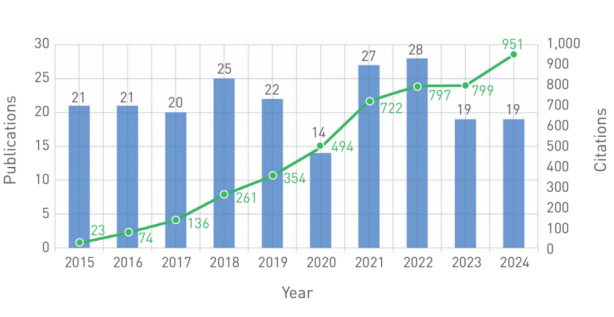
生物质能源空间规划领域的出版物数量与引文数量 © 张一飞,曲可晴,马晨烁,李蝉韵
国际合作关系分析
中介中心性用于衡量节点在网络结构中作为信息桥梁的能力。生物质能空间规划领域文献的国际合作关系网络及相关数据表明,美国、德国、荷兰发文量大,同时中介中心性最高,分别为0.24、0.2和0.19,起到国际合作枢纽的作用;相比之下,中国发文量大而中介中心性较低(0.02),在该领域的影响力仍有待提升。

生物质能源空间规划领域的国际合作网络 © 张一飞,曲可晴,马晨烁,李蝉韵
关键词聚类分析
关键词聚类侧重的是其本身的相似性,如语义、共现频率、词向量相似度等。节点类型选择“关键词”(Keyword),参数使用默认设置,得到关键词共现网络。
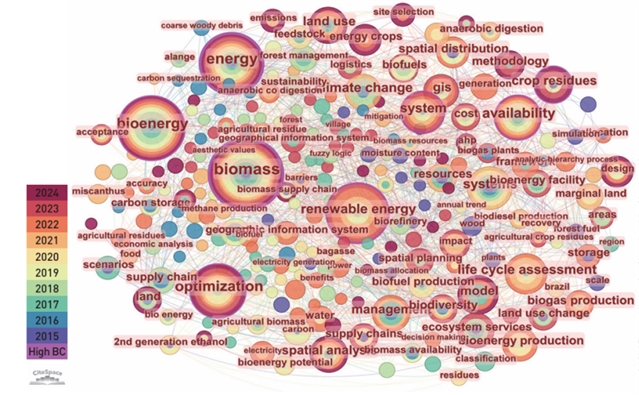
生物质能源空间规划领域的关键词共现网络 © 张一飞,曲可晴,马晨烁,李蝉韵
研究进一步利用CiteSpace的聚类与时间线视图功能,选取对数似然率聚类方法。为了获得更具可读性的聚类标签,本文选用标题词作为聚类命名依据。软件自动选取排名靠前的7个聚类标签,结果显示结构同质性高,内部一致性较高且聚类效果较为理想。

生物质能源空间规划领域中关键词共现聚类的时间演变 © 张一飞,曲可晴,马晨烁,李蝉韵
能源景观视角下的生物质能空间运营逻辑
能源景观涵盖的产业过程可以通过能源需求、供应和流动来描述,从而帮助识别能源生产、转换、分配与消费之间的路径耦合,空间规划、政策制定或社会接受度等方面的限制,以及能源系统与其他社会经济系统之间的重要关联。本研究依此思路,提炼出“资源–供应链–需求–优化”的空间运营逻辑。
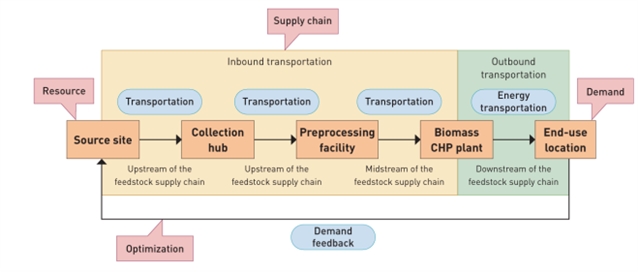
典型生物质能源供应路径与终端应用示意图 © 张一飞,曲可晴,马晨烁,李蝉韵
生物质能空间规划研究框架
为了系统性地认识生物质能空间规划,理解多种空间尺度下的生物质能生产–使用过程,研究基于现状探索短期或长期未来情景,结合生物质能空间运营逻辑,建立“资源–供应链–需求–优化”的逻辑关系和研究框架,涵盖资源潜力评估、供应链、能源需求和供需空间匹配优化四部分。
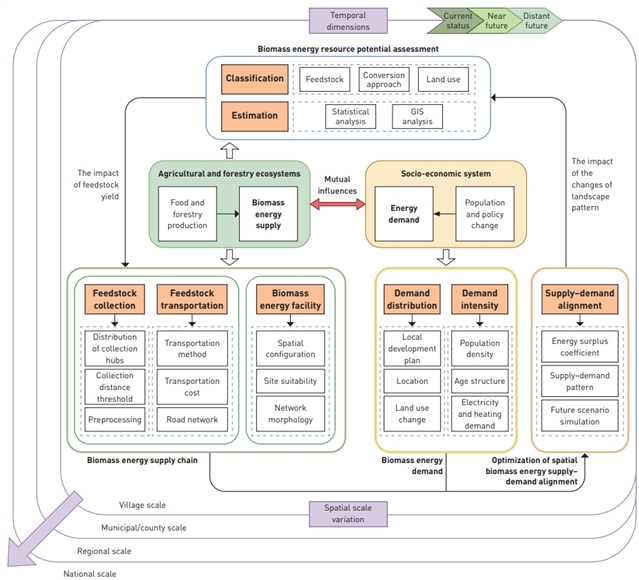
生物质能源空间规划研究框架 © 张一飞,曲可晴,马晨烁,李蝉韵
03.研究进展
生物质能潜力评估
评估生物质能开发潜力并确切描述其空间分布特征,是明确能源用途并形成发展规划的基本条件。同时,生物质能原料和转化工艺的多样性也增加了生物质能潜力评估的复杂性。现有生物质能潜力评估分为三类:第一,理论和技术潜力的估算;第二,以需求为导向的潜力估算,包括经济潜力和实施潜力;第三,链接理论潜力和可持续实施潜力的综合建模评估。
生物质能供应链
生物质能供应链是原料从收集、加工到投入使用,最终形成燃料产品的过程。相关研究主要聚焦于提升经济效益,或实现复杂体系中的多目标优化并形成最优决策。供应链与用户的需求和利益密切相关,其决策成果将直接影响生物质能的社会接受度。地理空间规划视角下的生物质能供应链研究主要关注能源设施的位置与数量及其处理、转化与生产能力,以及不同处理设施之间的生物质分配和运输方式。
生物质能原料收集与预处理
生物质原料收集相关研究侧重于在生物质到达预处理设施之前的过程,现有研究以区域至村镇尺度为主。收集所得的生物质原料通常可在出产地、生物质转换工厂或原料收集点存储。作为原料产地与热电厂之间的中转站,原料收集点的选址需要优先考虑生物量高且运输距离短的区域。通常会在原料收集阶段对生物质原料进行预处理,将其转化为能量密度更高的能源载体,提升能量转化率。同时,也可通过增设预处理点提升储存和运输效率。
生物质能运输
对物流的研究需要将生物质的运输方式、运输成本、路网可达性均纳入考量,以有效提高决策的可行性。目前公路运输占主导地位,并有伴随铁路运输、水路运输、管道运输形成多式联运的趋势。生物质供应链运输成本研究涉及借助多种模型和可行性分析的路线开发、运输工具类型和容量的选择与时间表制定,以及如何减少供应链运输成本、缩短运营时间、减弱对环境的影响。
生物质热电厂选址与网络布局
建设和运营生物质热电厂是被普遍认可的高效发展生物质能的方式之一。生物质热电厂选址需要考虑当地气候条件和环境特征,应对资源供应问题与环境风险,避免对自然环境产生负面影响,还应符合当地城市发展规划和生态保护要求。
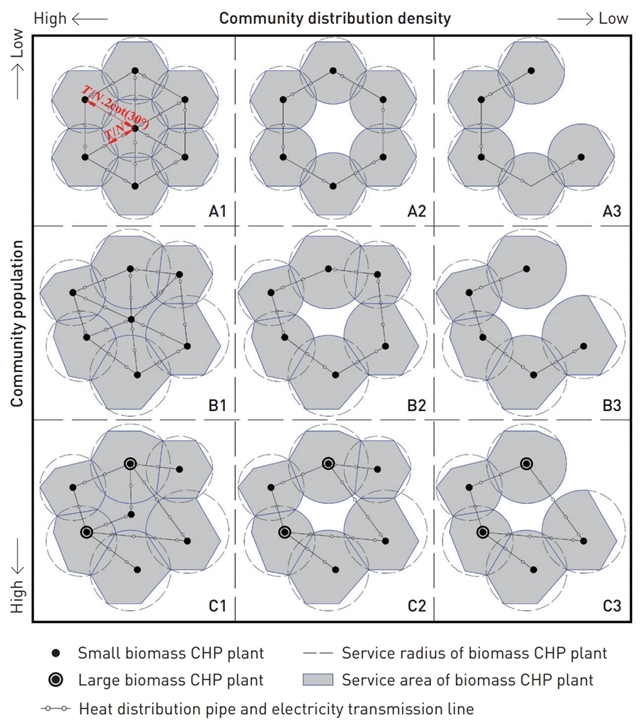
生物质热电联产厂的理想网络配置(A1)与实际配置(其它) © 张一飞,曲可晴,马晨烁,李蝉韵
总体而言,供应链研究可从资源分布、加工流程、运输路径、设施选址和物流成本等方面为国土空间规划提供科学支撑。
生物质能需求
生物质能需求与其价格、国内生产总值(GDP)、人口等方面密切相关。具有空间属性的能源需求研究包含需求分布与需求强度两个维度,相关指标的估算和预测因受市场和政策的影响而极具挑战性。
生物质能需求分布
需求分布的不均衡性给热电厂的选址及城市能源空间布局带来了挑战。宏观尺度上,纬度变化造成的季节性需求波动尤为突出——供暖和制冷需求都是能源需求的重要构成。在非采暖期纬度与生物质热电厂人均原料消耗量呈线性负相关,而在采暖期呈“反S”型关系。同时,生物质能需求的空间分布会随研究尺度的扩大而复杂化,生物质能对区域尺度乡村居民生活质量的提升显著高于个人尺度。
生物质能需求强度
能源需求强度通常以单位GDP所消耗的能源来衡量。人口是决定能源需求的核心要素,其分布和迁移特征有助于理解能源需求的特征与强度,如人口增长、人口的城市化迁移和人口密度变化等。此外,教育水平、年龄结构等人口特征也是能源需求研究的重要因素。
生物质能供需空间匹配优化
生物质能供需匹配分析可识别动态时空下潜在的资源短缺或过剩区域,增强国土空间规划应对未来能源市场需求不确定性的韧性,是探索生物经济可持续发展路径的关键方法。在资源供需关系分析基础上,结合情景模拟结果,可对能源设施布局与供应链路径进行空间优化。“需求反馈”部分体现了模型对未来需求变化的响应机制,实现从预测到规划的动态闭环。情景模拟研究通过设置不同驱动因素的方式来预估规划和决策成果。未来情景模拟有助于权衡不同情景下多种生态系统服务的效益,进而设立生态保护或修复项目以补偿潜在损失。
04.研究趋势与未来展望
全球研究趋势
研究进一步细化全球生物质能领域的研究特点,选择发文量前十的国家和地区,分别提取中介中心性最高的五个关键词为研究热点,提取持续出现的聚类主题为未来研究趋势(表1)。
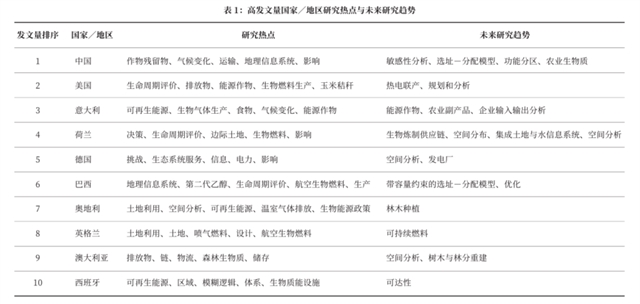
未来展望
结合前述研究热点、现有研究内容和研究趋势,本文提出未来生物质能空间规划研究可从以下五个方向展开:1)建设数据库与精确核算体系。2)优化多尺度决策模型。3)提升能源需求评估与供需对接能力。4)建立供需预测的动态优化与智能化决策体系。5)衔接生物质能空间规划与国土空间规划。
05.结语
本研究梳理了生物质能空间规划的核心内容,并基于能源景观理论构建了涵盖生物质能潜力评估、供应链、能源需求分析、供需匹配优化的研究框架。在实践应用层面,本研究可对规划设计学科提供以下参考:在国土空间规划中优化生物质能布局,提高土地利用效率,推动生物质能开发与城乡发展融合;实现精细化能源规划,利用GIS技术进行空间分析,提高生物质能设施选址的科学性;结合能源景观理论,推动生态友好的能源设计;建立多目标优化模型,兼顾经济、环境和社会效益,推动可持续能源规划。本研究还可为政府部门和能源企业提供科学的生物质能空间布局方法,为相关产业政策制定、农业废弃物资源化、农村清洁能源利用等方向提供参考。
参考文献
[1] Maamoun, N., Kennedy, R., Jin, X., & Urpelainen, J. (2020). Identifying coal-fired power plants for early retirement. Renewable and Sustainable Energy Reviews, (126), 109833.
[2] Zhuang, X., Zhang, X., Zhang, Q., Chen, L., & Ma, L. (2024). Development status and challenges of biomass energy utilization technology under background of emission peak and carbon neutrality strategy in China. Solar Energy, 7(363), 40–49.
[3] International Energy Agency. (n.d.). Bioenergy.
[4] Lu, Y. (2014). Review and prospect of clean, renewable energy utilization. Science & Technology Review, 32(Z2), 15–26.
[5] Hepbasli, A. (2008). A key review on exergetic analysis and assessment of renewable energy resources for a sustainable future. Renewable and Sustainable Energy Reviews, 12(3), 593–661.
[6] de Waal, R., & Stremke, S. (2014). Energy transition: Missed opportunities and emerging challenges for landscape planning and designing. Sustainability, 6(7), 4386–4415.
[7] Ramirez Camargo, L., & Stoeglehner, G. (2018). Spatiotemporal modelling for integrated spatial and energy planning. Energy, Sustainability and Society, 8(1), 32.
[8] Wolsink, M. (2012). The research agenda on social acceptance of distributed generation in smart grids: Renewable as common pool resources. Renewable and Sustainable Energy Reviews, 16(1), 822–835.
[9] Blaschke, T., Biberacher, M., Gadocha, S., & Schardinger, I. (2013). ‘Energy landscapes’: Meeting energy demands and human aspirations. Biomass and Bioenergy, (55), 3–16.
[10] Howard, D. C., Burgess, P. J., Butler, S. J., Carver, S. J., Cockerill, T., Coleby, A. M., Gan, G., Goodier, C. J., Van der Horst, D., Hubacek, K., Lord, R., Mead, A., Rivas-Casado, M., Wadsworth, R., & Scholefield, P. (2013). Energyscapes: Linking the energy system and ecosystem services in real landscapes. Biomass and Bioenergy, (55), 17–26.
[11] Ginelli, E., & Daglio, L. (2014). Energyscapes: Developing a Multiscalar Systemic Approach to Assess the Environmental, Social and Economic Impact of Renewable Energy Systems on Landscape. Proceedings of the 2nd International Conference on Architecture and Urban Design (ICAUD 2014). Epoka University Press.
[12] Geng, A., Pan, W., & Yang, H. (2020). Quantifying the mitigating effects and benefits from substituting wood biomass for coal in energy production in China. Resources Science, 42(3), 536–547.
[13] Cho, S., & Kim, J. (2019). Multi-site and multi-period optimization model for strategic planning of a renewable hydrogen energy network from biomass waste and energy crops. Energy, (185), 527–540.
[14] Nebey, A. H., Taye, B. Z., & Workineh, T. G. (2020). Site suitability analysis of solar PV power generation in South Gondar, Amhara Region. Journal of Energy, (2020), 3519257.
[15] Sun, Y., Wang, R., Liu, J., Xiao, L., Lin, Y., & Kao, W. (2013). Spatial planning framework for biomass resources for power production at regional level: A case study for Fujian Province, China. Applied Energy, (106), 391–406.
[16] Song, J., Liu, C., Xing, J., Yang, W., & Ren, J. (2023). Linking bioenergy production by agricultural residues to sustainable development goals: Prospects by 2030 in China. Energy Conversion and Management, (276), 116568.
[17] Xin, B., Lyu, L., Wang, S., Dong, J., Zhang, N., & Yang, C. (2024). Research progress of biomass energy field based on bibliometric investigation. China Environmental Science, 44(4), 1875–1884.
[18] Zhang, Y., Yang, H., & Liu, L. (2024). Comparative analysis of biomass energy research in China and America. World Sci-Tech R&D.
[19] Chen, C. (2006). CiteSpace II: Detecting and visualizing emerging trends and transient patterns in scientific literature. Journal of the American Society for Information Science and Technology, 57(3), 359–377.
[20] de Jong, J., & Stremke, S. (2020). Evolution of energy landscapes: A regional case study in the Western Netherlands. Sustainability, 12(11), 4554.
[21] Wang, C., Chang, Y., Zhang, L., Pang, M., & Hao, Y. (2017). A life-cycle comparison of the energy, environmental and economic impacts of coal versus wood pellets for generating heat in China. Energy, (120), 374–384.
[22] Martinez-Valencia, L., Camenzind, D., Wigmosta, M., Garcia-Perez, M., & Wolcott, M. (2021). Biomass supply chain equipment for renewable fuels production: A review. Biomass and Bioenergy, (148), 106054.
[23] Rimppi, H., Uusitalo, V., Väisänen, S., & Soukka, R. (2016). Sustainability criteria and indicators of bioenergy systems from steering, research and Finnish bioenergy business operators’ perspectives. Ecological Indicators, (66), 357–368.
[24] Liu, Z., Wang, Y., & Ding, Y. (2023). Evaluation of biomass energy resource potential and emission reduction of energy-based pollutants in Shaanxi Province. Environmental Science and Management, 48(11), 22–27.
[25] Bilandzija, N., Voca, N., Jelcic, B., Jurisic, V., Matin, A., Grubor, M., & Kricka, T. (2018). Evaluation of Croatian agricultural solid biomass energy potential. Renewable and Sustainable Energy Reviews, (93), 225–230.
[26] Anitescu, G., & Bruno, T. J. (2012). Liquid biofuels: Fluid properties to optimize feedstock selection, processing, refining/blending, storage/transportation, and combustion. Energy & Fuels, 26(1), 324–348.
[27] Fu, J., Yan, X., & Jiang, D. (2021). Assessing the sweet sorghum-based ethanol potential on saline–alkali land with DSSAT model and LCA approach. Biotechnology for Biofuels, 14(1), 44.
[28] Zhang, R., & Shen, W. (2021). Research and prospects on the evaluation of the potential of agriculture and forestry biomass resources. China Forestry Economics, (6), 46–49.
[29] Zhou, Y., Wang, J., Wang, S., Xi, F., Bing, L., Yin, Y., Hu, Q., & Zhang, L. (2024). Assessment of biomass resources for energy use potential in China. Chinese Journal of Ecology, 43(9), 2702–2713.
[30] Nie, Y., Chang, S., Cai, W., Wang, C., Fu, J., Hui, J., Yu, L., Zhu, W., Huang, G., Kumar, A., Guo, W., & Ding, Q. (2020). Spatial distribution of usable biomass feedstock and technical bioenergy potential in China. GCB Bioenergy, 12(1), 54–70.
[31] Yan, P., Xiao, C., Xu, L., Yu, G., Li, A., Piao, S., & He, N. (2020). Biomass energy in China’s terrestrial ecosystems: Insights into the nation’s sustainable energy supply. Renewable and Sustainable Energy Reviews, (127), 109857.
[32] Dabas, J., Mondal, S., & Thapar, S. (2023). Application of geospatial technology for assessment of agricultural residue based renewable energy potential in Punjab, India. Energy for Sustainable Development, (72), 340–350.
[33] Younis, A., Trujillo, Y., Benders, R., & Faaij, A. (2021). Regionalized cost supply potential of bioenergy crops and residues in Colombia: A hybrid statistical balance and land suitability allocation scenario analysis. Biomass and Bioenergy, (150), 106096.
[34] Cao, X., Sun, B., Chen, H., Zhou, J., Song, X., Liu, X., Deng, X., Li, X., Zhao, Y., Zhang, J., & Li, J. (2021). Approaches and research progresses of marginal land productivity expansion and ecological benefit improvement in China. Bulletin of the Chinese Academy of Sciences, 36(3), 336–348.
[35] Fu, J., Du, J., Jiang, D., & Wang, D. (2020). Analysis of the marginal land resources suitable for developing liquid biofuel in China. Science & Technology Review, (11), 31–40.
[36] Viccaro, M., Caniani, D., Masi, S., Romano, S., & Cozzi, M. (2022). Biofuels or not biofuels? The “Nexus Thinking” in land suitability analysis for energy crops. Renewable Energy, (187), 1050–1064.
[37] Cervelli, E., Recchi, P. F., Fagnano, M., di Perta, E. S., & Pindozzi, S. (2024). Marginal lands between recovery and valorization. An inclusive definition to support bio-energy supply chains. The Southern Italy contexts case study. Agricultural Systems, (217), 103951.
[38] Chen, X. (2016). Economic potential of biomass supply from crop residues in China. Applied Energy, (166), 141–149.
[39] Chukwuma, E. C., Okey-Onyesolu, F. C., Ani, K. A., & Nwanna, E. C. (2021). GIS bio-waste assessment and suitability analysis for biogas power plant: A case study of Anambra state of Nigeria. Renewable Energy, (163), 1182–1194.
[40] Wolfsmayr, U. J., & Rauch, P. (2014). The primary forest fuel supply chain: A literature review. Biomass & Bioenergy, (60), 203–221.
[41] Mamo, T., Montastruc, L., Negny, S., & Dendena, L. (2024). Considering economic-environmental dimension in the integrated strategic and tactical optimization of Ethiopia’s bioethanol supply chain coupled with operational planning. Computers and Chemical Engineering, (189), 108781.
[42] Lin, T., Rodríguez, L. F., Shastri, Y. N., Hansen, A. C., & Ting, K. C. (2013). GIS-enabled biomass‐ethanol supply chain optimization: Model development and Miscanthus application. Biofuels, Bioproducts and Biorefining, 7(3), 314–333.
[43] Mamo, T., Montastruc, L., Negny, S., & Dendena, L. (2023). Integreted strategic and tactical optimization planning of biomass to bioethanol supply chains coupled with operational plan using vehicle routing: A case study in Ethiopia. Computers and Chemical Engineering, (172), 108186.
[44] Sánchez-García, S., Athanassiadis, D., Martínez-Alonso, C., Tolosana, E., Majada, J., & Canga, E. (2017). A GIS methodology for optimal location of a wood-fired power plant: Quantification of available woodfuel, supply chain costs and GHG emissions. Journal of Cleaner Production, (157), 201–212.
[45] Wu, J., Zhang, J., Yi, W., Cai, H., Li, Y., & Su, Z. (2022). Agri-biomass supply chain optimization in north China: Model development and application. Energy, (239), 122374.
[46] Balaman, E. Y., Wright, D. G., Scott, J., & Matopoulos, A. (2018). Network design and technology management for waste to energy production: An integrated optimization framework under the principles of circular economy. Energy, (143), 911–933.
[47] Morato, T., Vaezi, M., & Kumar, A. (2019). Developing a framework to optimally locate biomass collection points to improve the biomass-based energy facilities locating procedure—A case study for Bolivia. Renewable and Sustainable Energy Reviews, (107), 183–199.
[48] Cao, J., Pang, B., Mo, X., & Xu, F. (2016). A new model that using transfer stations for straw collection and transportation in the rural areas of China: A case of Jinghai, Tianjin. Renewable Energy, (99), 911–918.
[49] Tang, Z.-H., Liang, C., & Zhang, R.-C. (2023). Optimizing crop residues collection patterns in rural areas to reduce transportation costs and carbon emissions. Environmental Technology & Innovation, (32), 103367.
[50] Mafakheri, F., & Nasiri, F. (2014). Modeling of biomass-to-energy supply chain operations: Applications, challenges and research directions. Energy Policy, (67), 116–126.
[51] Mohd Idris, M. N., Hashim, H., & Razak, N. H. (2018). Spatial optimisation of oil palm biomass co-firing for emissions reduction in coal-fired power plant. Journal of Cleaner Production, (172), 3428–3447.
[52] Flodén, J. (2016). Opportunities and challenges for rail transport of solid wood biofuel. European Journal of Transport and Infrastructure Research, 16(4), 512–553.
[53] Stephen, J. D., Mabee, W. E., & Saddler, J. N. (2010). Biomass logistics as a determinant of second-generation biofuel facility scale, location and technology selection. Biofuels, Bioproducts & Biorefining, 4(5), 503–518.
[54] Ko, S., Lautala, P., & Handler, R. M. (2018). Securing the feedstock procurement for bioenergy products: A literature review on the biomass transportation and logistics. Journal of Cleaner Production, (200), 205–218.
[55] Mirkouei, A., Haapala, K. R., Sessions, J., & Murthy, G. S. (2017). A mixed biomass-based energy supply chain for enhancing economic and environmental sustainability benefits: A multi-criteria decision making framework. Applied Energy, (206), 1088–1101.
[56] Schröder, M., & Cabral, P. (2019b). Eco-friendly 3D-Routing: A GIS based 3D-Routing-Model to estimate and reduce CO2-emissions of distribution transports. Computers, Environment and Urban Systems, (73), 40–55.
[57] Golecha, R., & Gan, J. (2016). Biomass transport cost from field to conversion facility when biomass yield density and road network vary with transport radius. Applied Energy, (164), 321–331.
[58] Levihn, F., & Nuur, C. (2014). Biomass and waste incineration CHP: The co-benefits of primary energy savings, reduced emissions and costs. WIT Transactions on Ecology and the Environment, (190), 127–138.
[59] Zhao, B., Wang, H., Huang, Z., & Sun, Q. (2022). Location mapping for constructing biomass power plant using multi-criteria decision-making method. Sustainable Energy Technologies and Assessments, (49), 101707.
[60] Mokarram, M., Shafie-Khah, M., & Aghaei, J. (2021). Risk-based multi-criteria decision analysis of gas power plants placement in semi-arid regions. Energy Reports, (7), 3362–3372.
[61] Pergola, M., Rita, A., Tortora, A., Castellaneta, M., Borghetti, M., De Franchi, A. S., Lapolla, A., Moretti, N., Pecora, G., Pierangeli, D., Todaro, L., & Ripullone, F. (2020). Identification of suitable areas for biomass power plant construction through environmental impact assessment of forest harvesting residues transportation. Energies, 13(11), 2699.
[62] Franco, C., Bojesen, M., Hougaard, J. L., & Nielsen, K. (2015). A fuzzy approach to a multiple criteria and Geographical Information System for decision support on suitable locations for biogas plants. Applied Energy, (140), 304–315.
[63] Ma, C., Zhang, Y., & Ma, K. (2022). The effect of biomass raw material collection distance on energy surplus factor. Journal of Environmental Management, (317), 115461.
[64] Zhang, Y., & Kang, J. (2018). Effect of the distribution density of biomass combined heat and power plant networks on total energy utilization efficiency. Journal of Renewable and Sustainable Energy, 10(6), 065902.
[65] Wolf, G. W. (2022). Solving location-allocation problems with professional optimization software. Transactions in GIS, 26(7), 2741–2775.
[66] Suganthi, L., & Samuel, A. A. (2012). Energy models for demand forecasting—A review. Renewable and Sustainable Energy Reviews, 16(2), 1223–1240.
[67] Peng, C., Li, Z., Xu, Q., Li, X., Li, X., & Chen, H. (2024). Spatial distribution of energy consumption: Integrating climate and macro-statistics for insights from clustering and sensitivity analysis. Energy & Buildings, (318), 114446.
[68] Ma, C., Zhang, Y., & Zhao, W. (2021). Influence of latitude on raw material consumption by biomass combined heat and power plants: Energy conservation study of 50 cities and counties in the cold region of China. Journal of Cleaner Production, (278), 123796.
[69] Venghaus, S., & Hoffmann, J. (2016). The impacts of energy from biomass on the perceived quality of life of the rural population in Brandenburg, Germany. Innovation: The European Journal of Social Science Research, (29), 337–372.
[70] Li, L., Zhang, J., Tang, L., & Yu, L. (2017). Analysis on factors of China’s energy intensity changes for 1997–2012: Based on structural decomposition analysis. Chinese Journal of Management Science, 25(9), 125–132.
[71] Yasmeen, R., Cui, Z., Shah, W. U. H., Kamal, M. A., & Khan, A. (2022). Exploring the role of biomass energy consumption, ecological footprint through FDI and technological innovation in B&R economies: A simultaneous equation approach. Energy, (244), 122703.
[72] Mutschler, R., Rüdisüli, M., Heer, P., & Eggimann, S. (2021). Benchmarking cooling and heating energy demands considering climate change, population growth and cooling device uptake. Applied Energy, (288), 116636.
[73] Hao, Y., Wang, L., Fan, W., Wei, Y., Wen, T., & Zhang, K. (2018). What determines China’s electricity consumption? New evidence using the logarithmic mean Divisia index method. Journal of Renewable and Sustainable Energy, (10), 015909.
[74] Wang, S., Xie, Z., & Wu, R. (2020). Examining the effects of education level inequality on energy consumption: Evidence from Guangdong Province. Journal of Environmental Management, (269), 110761.
[75] Otsuka, A. (2018). Population agglomeration and residential energy consumption: Evidence from Japan. Sustainability, 10(2), 469.
[76] Zhang, Y., Qin, C., & Liu, Y. (2018). Effects of population density of a village and town system on the transportation cost for a biomass combined heat and power plant. Journal of Environmental Management, (223), 444–451.
[77] Li, J., Guo, J., & Yuan, Q. (2018). Forecast of energy demand and policy impact under the background of the coordinated development in Beijing–Tianjin–Hebei region. Journal of Arid Zone Resources and Environment, 32(5), 5–11.
[78] Popp, J., Kovács, S., Oláh, J., Divéki, Z., & Balázs, E. (2021). Bioeconomy: Biomass and biomass-based energy supply and demand. New Biotechnology, (60), 76–84.
[79] Cintas, O., Berndes, G., Englund, O., & Johnsson, F. (2021). Geospatial supply-demand modeling of lignocellulosic biomass for electricity and biofuels in the European Union. Biomass and Bioenergy, (144), 105870.
[80] He, Y., Zhang, Y., & Ma, K. (2024). A comprehensive planning study on the thermal potential of various biomass conversion technologies: Case study of 47 cities in China. Journal of Cleaner Production, (437), 140305.
[81] Hassan, Q., Algburi, S., Al-Musawi, T. J., Viktor, P., Jaszczur, M., Barakat, M., Sameen, A. Z., & Hussein, A. H. (2024). GIS-based multi-criteria analysis for solar, wind, and biomass energy potential: A case study of Iraq with implications for climate goals. Results in Engineering, (22), 102212.
[82] Lemm, R., Haymoz, R., Gurung, A. B., Burg, V., Strebel, T., & Thees, O. (2020). Replacing fossil fuels and nuclear power with renewable energy: Utopia or valid option? A Swiss case study of bioenergy. Energies, 13(8), 2051.
[83] Shi, Z., Ferrari, G., Ai, P., Marinello, F., & Pezzuolo, A. (2024). Bioenergy potential from agricultural by-product in 2030: An AI-based spatial analysis and climate change scenarios in a Chinese region. Journal of Cleaner Production, (436), 140621.
[84] Nie, Y., Cai, W., Wang, C., Huang, G., Ding, Q., Yu, L., Li, H., & Ji, D. (2019). Assessment of the potential and distribution of an energy crop at 1-km resolution from 2010 to 2100 in China—The case of sweet sorghum. Applied Energy, (239), 395–407.
[85] Cervelli, E., di Perta, E. S., & Pindozzi, S. (2020). Energy crops in marginal areas: Scenario-based assessment through ecosystem services, as support to sustainable development. Ecological Indicators, (113), 106180.

《前沿》系列英文学术期刊
由教育部主管、高等教育出版社主办的《前沿》(Frontiers)系列英文学术期刊,于2006年正式创刊,以网络版和印刷版向全球发行。系列期刊包括基础科学、生命科学、工程技术和人文社会科学四个主题,是我国覆盖学科最广泛的英文学术期刊群,其中12种被SCI收录,其他也被A&HCI、Ei、MEDLINE或相应学科国际权威检索系统收录,具有一定的国际学术影响力。系列期刊采用在线优先出版方式,保证文章以最快速度发表。
中国学术前沿期刊网
http://journal.hep.com.cn

特别声明:本文转载仅仅是出于传播信息的需要,并不意味着代表本网站观点或证实其内容的真实性;如其他媒体、网站或个人从本网站转载使用,须保留本网站注明的“来源”,并自负版权等法律责任;作者如果不希望被转载或者联系转载稿费等事宜,请与我们接洽。